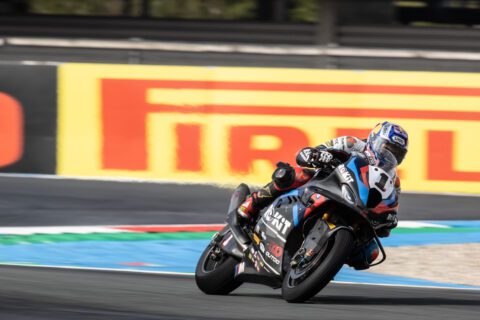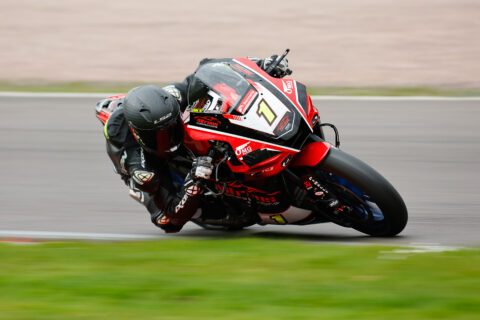When Bruce Anstey smashed the outright lap record around the Mountain Course on the final lap of last year’s Superbike TT with a speed of 132.298mph - becoming the first man to break the 132mph barrier in the process - it got many people speculating as to just what might be possible around the iconic 37 and ¾-mile course. In particular, the possibility that we might soon witness the first sub 17-minute lap.
Almost seven seconds need to be found – by Anstey alone – for that to happen, which is tough going to say the least, but the speculation has a distinct sense of realism about it when the sector times are analysed. Putting the three best individual times would give a new absolute lap record a staggering 10.267s quicker than Anstey’s mark.
The ‘perfect lap’, based on the fastest recorded sectors in history, equates to a time of 16 minutes 56.415 seconds (133.634mph) - well inside Anstey’s record lap. Strangely, the Kiwi isn’t the quickest in any of the six sectors, with Michael Dunlop, Steve Plater and Michael Rutter holding the records.
Unsurprisingly, Dunlop’s blistering 2014 TT on the factory BMW saw him post the quickest ever times in three sectors (Start-Glen Helen, Glen Helen-Ballaugh and Ballaugh-Ramsey), but perhaps the most impressive sector times come from Plater who, despite not competing at the TT since 2009, still holds the fastest sector times between Ramsey Hairpin and the Bungalow and the Bungalow to Cronk-ny-Mona.
The final sector is significantly the smallest but no less important, as many a race has been won and lost over the closing miles of Cronk-ny-Mona to the Grandstand and it’s Rutter reigning supreme here, having set his time on the final lap of the 2013 Senior.
The sub 17-minute lap would, without question, be the perfect lap of the Mountain Course so what exactly do some of the main protagonists think is possible?
Plater only competed at the TT between 2007 and 2009 but in that time, he won two races – the 2008 Supersport and 2009 Senior – and lapped at more than 130mph, which, at the time, only three riders had achieved. And, almost six years ago he set speeds over the Mountain that no-one has come near to since.
“To be honest, I’m a bit surprised to still be the quickest over those two sectors and I never really gave it much thought until everyone started talking about it recently,” began Plater. “I do remember Ian Simpson telling me that he’d never seen anyone as quick as me over there though, and I guess everything clicked for me up and down the Mountain.”
The Lincolnshire man believes a sub 17-minute lap is most certainly possible, but one that he also feels is an incredibly tall order.
“Looking at everyone’s fastest laps, a good chunk of time needs to be found to get below 17 minutes and even for Bruce you’re talking almost seven seconds, which is a big ask. It’s almost bizarre that he’s not the fastest in any sector but finding time at those speeds is very difficult and you really would need everything – and I mean everything – to come together for it to happen. Over a 37 and ¾ mile lap, that’s difficult. You’ll never get a perfect lap at the TT.”
Plater cites variables such as weather being in your favour; and needing plenty of grip. Plater’s debut year, 2007, saw perfect weather throughout the fortnight – something that we haven’t really seen since – and come Senior race day, visible black lines, where rubber had been laid down, could be seen at practically every corner.
The Englishman also feels that if anyone is to make inroads on Anstey’s performance, Michael Dunlop and John McGuinness could be the ones to scale new heights.
“The fact that he doesn’t have the outright lap record will be eating away at Michael. And there’s no denying we didn’t get to see what he was ultimately capable of last year. He used his head and didn’t need to push any harder when he got ahead, but we all know he could have gone quicker if he needed to.
“John still has plenty more speed in him too. He’s definitely capable of 132mph+ laps. But for that to happen, he needs to ignore everything else that’s going on around him, get himself properly fit and give it everything he has. John’s capable of so much more and we could certainly see some super-fast laps from him.”
The visible black lines in 2007 gave tyres the perfect opportunity to work their magic, and Pat Walsh believes that if given the right type of weather Dunlop’s tyres could certainly contribute toward a record-breaking feat.
Tyres have always played an integral part in performance and no-one knows more about how they work at the TT than Walsh, who’s been with Dunlop for 20 years. Now the UK Sales Manager Motorcycle Race, he has seen Dunlop directly connected with 60 race wins and over 150 podium places at the TT since 2000. And not only do they hold lap records and race records in every class, Dunlop, Plater and Rutter were all on Dunlops when their rapid sector times were recorded.
The tyre manufacturer has worked closely with top teams and riders for many years, something that has helped enormously with the evolution in tyre design. They’re continually striving to improve on warm up, grip, stability, corner entry and exit and the TT is the perfect litmus test each year.
“The factory supported teams opt to change tyres when refuelling after the second and fourth laps,” said Walsh. “A softer compound is offered for those requiring a two-lap tyre. We also have many riders who require a tyre to do the full six-lap race. Our experience here at Dunlop is epitomised by us being able offer a tyre capable of this.
“Indeed, we have enjoyed many podiums and top 10 finishes with riders using one rear tyre for the whole race. This is a glowing tribute to our product.”
As Plater mentioned, if anyone is to break Anstey’s record then the likes of Michael Dunlop and John McGuinness seem best placed to cash in, provided they’re at the top of their game come race week. Luckily, Dunlop has the experience of Mick Shanley to tackle the mountain, and the lap record. Shanley is a vital weapon in the Northern Irishman’s arsenal and taking him to new heights is something the crew chief is determined to achieve.
“At the level the bikes are performing at now, and the way the riders are riding, it’s only a matter of time before we see a sub 17-minute lap,” said Shanley. “The best sector times show what’s possible and the fact that the lap record holder doesn’t have one of those emphasises that even more.
“The sectors are so vast that it’s impossible to pinpoint corners and what the bike’s doing at them, but we go through them, as you can pinpoint areas of strength and weakness. Ballaugh to Ramsey is perhaps the most crucial, in terms of the bike’s handling, as it’s a bumpy, high speed run where it’s vital to keep momentum going.”
The crew chief also believes the bikes are more bullet proof than they’ve ever been, with the Superstock class seeming the best proving ground for this. The fact that they can lap at 131mph and then, essentially, be ridden on the road the next day shows a manufacturer’s quality in all its glory.
As much as bike development, tyres and rider makes a difference, course changes over the years have undoubtedly played a part in speeds increasing too, whether it’s been simple resurfacing or the profiles of corners altering.
General resurfacing continually takes place – the once infamous Sulby Straight has never been smoother – but almost all of the course changes are carried out by the Manx Government to improve road traffic issues not to necessarily improve the circuit for racing.
There’s no doubt that lap records being broken gives the Isle of Man TT powers that be an opportunity to promote and publicize this great event even more. Paul Phillips and his team were quick to spot this after Anstey’s feats and the Motorcycle Live Show at the NEC saw them do exactly that.
Phillips admits the sub 17-minute lap is a difficult task but it is something that excites him and everyone connected with the event.
The TT boss was, like everyone else, mesmerised by Anstey’s amazing lap but the laid-back Kiwi remembers it as a lap that wasn’t all plain-sailing to begin with. Anstey’s effort on the Valvoline Racing/Padgetts Honda in the Superbike race had begun well, but when he overshot The Nook things seemed as far away from record-lap territory as you can imagine.
A dismount and the obligatory three point turn got him back on track, but by then sat in 14th, it looked as if he had left himself plenty of work just to bag a podium.
“I don’t know why but it took me ages to get going,” the Kiwi said. “Michael (Dunlop) caught me half way round the first lap and I thought ‘I really need to hang on to him’ but then I ran wide at the Nook and that was it.
“I kept plugging away and slowly moved up a few places but it wasn’t until the fifth and sixth lap when everything came together. That last lap was a really good lap and it could have been a bit quicker as I lost a second when I ran right out to the bales at the Creg and tore the barriers.
“The rear tyre felt really good and the whole bike felt great so I put everything into it. There was nobody in front of me so I wasn’t getting a tow or anything whilst I met the tail-enders at all the right places and didn’t lose any time.”
A man so laid back he’s almost horizontal at times, Anstey is known for having a habit of starting his race at his own pace and then easing into it, increasing his speed as the race progresses. It’s not a straight-forward way of racing, but nine TT wins and 31 podiums around the mountain make it hard to argue with this very personal approach that the man from New Zealand adopts.
Anstey’s deeds will always sit proudly in the record books, but if his record-breaking lap is anything to go by – it had some mishaps – then surely the sub 17-minute lap is something both Michael Dunlop and John McGuinness, among others, will feel they could one day achieve. Will it be in 2015? It’s conceivable. Decent weather and competitors riding on the absolute edge could see to that.


![Shane Byrne, Monstermob Ducati, 2003 WorldSBK, action [Gold & Goose]](https://bikesportnews.com/wp-content/uploads/2025/07/Shane-Byrne-Monstermob-Ducati-2003-WorldSBK-action-Gold-Goose-480x272.jpg)







